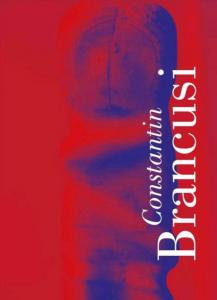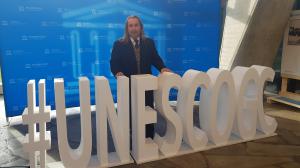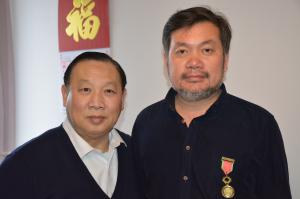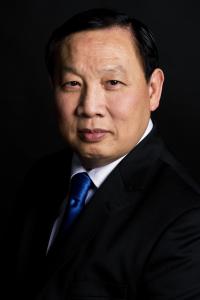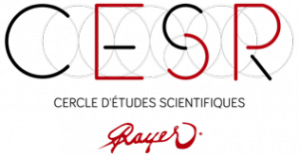The Cercle d'Etudes Scientifiques Rayer welcomes the traditional Chinese art represented by Cai Yinlong to UNESCO
The Cercle d'Etudes Scientifiques Rayer welcomes the traditional Chinese art represented by Cai Yinlong to UNESCO
PARIS, FRANCE, September 4, 2020 /EINPresswire.com/ -- Chinese arts are among the oldest artistic traditions in the world. Chinese painting is a very complete art, combining techniques of calligraphy, painting and poetry.
Unlike traditional Western figurative painting, Chinese painting is not just a visual representation of what the artist sees or imagines, it is more the expression of a way of thinking, highlighting the harmony between man and the universe, and the dynamism of this relationship.
This is the reason why Thierry Rayer, president of the Cercle d'Etude Scientifiques Rayer, discoverer of the common origin of the cut of humanity, became interested in the work of master Cai Yinlong.
It was Constantin Brancusi's sculpture "Le baiser de 1905" that led to the discovery of the element "the universal knowledge and know-how of the process of Creation". This discovery revealed by the researcher Thierry Rayer concerns all communities, whatever their so-called cultural or religious origins. By its nature, the element is universalist and egalitarian in accordance with all the Declarations relating to Human Rights.
The "universal knowledge and know-how of the process of Creation" responds to a universal methodology that highlights an origin common to all cultures.
This methodology provides a key to understanding the architecture and art of each country that demonstrates the Universality of creation.
It uses exact sciences:
• Science, defined as the body of knowledge and studies of universal value, characterised by a method based on verifiable objective observations and rigorous reasoning.
• Biology,
• Geometry (theorems of Thales and Pythagoras...),
• Mathematics (the Fibonacci sequence, the golden number...).
The history of religions, sciences, arts and ancient civilizations makes it possible to determine very precisely the common link between the great achievements of all eras and cultures.
Each heritage of Humanity represents the symbol of Humanity and reveals ancient myths (notably Egyptian such as that of Isis) and presents symbols (fish, egg, foetus, pentagon...).
The "universal knowledge and know-how of the process of Creation" creates many bridges between the different cultures of the planet and brings together the great achievements of Humanity, thus enabling cultures to come closer together.
The element strengthens the bonds between all peoples. It is the guarantee of the cohesion of our Humanity.
The "universal knowledge and know-how of the process of Creation" has been used throughout the world from antiquity to modern times.
Concerning the landscape paintings of the master Cai Yinlong, Thierry Rayer has noticed a vitality and a kind of spirit of freedom. They contain a Taoist, Confucian, Zen spiritual philosophy and a deep humanistic spirit.
First of all, his landscape painting JIAOMO has completely broken with the traditional formula of landscape painting: forest trees, huts, bridges, layers of cliffs, steep cliffs, all written with wild, rough and arrogant grass, and a free spirit. Indestructible, his aim is not to express the form of these objects, but to express the spirit and style of mountains and rivers.
History of Chinese painting
We can trace the origins of Chinese painting all the way back to the Palaeolithic, with the petroglyphs painted on the rock faces of ancient sites, without being able to date them precisely.
The oldest traces of silk painting date back to the 3rd century BC, discovered in the Hunan province. It was during the imperial dynasties that Chinese painting truly acquired its letters of nobility.
At the time of the Jin Dynasty (265-420), painting was reserved for the aristocracy and the educated, the only people of the time who had the necessary time to master the art of using a brush, first for calligraphy and then for painting, the two arts being closely linked..
Figurative painting did not really flourish until the Tang Dynasty (618-907). The imperial court was then widely represented in all its splendour, notably by Zhou Fang. The Tang period also saw the birth of a new art form, that of the master Wu Daozi, who used only black ink spread with free brushstrokes, in contrast to the techniques known until then, where ink strokes were used as outlines for the highly colourful and detailed figures. It was also during this period that landscape painting flourished, monochromatic and sparse scenes, aiming more at expressing the rhythm of nature than its image.
During the Song period (960-1279), painting became a visual representation of Taoist and Buddhist concepts. It was also during this period that the poet Su Shi and her circle of educated people indulged in amateur painting, using their skills in calligraphy.
It was then during the Yuan Dynasty (1279-1368) that poetry and calligraphy were incorporated into painting, through calligraphic poems followed by the artist's seal, usually on one side of the painting.
Chinese minimalist art only developed in the 12th century, during the Ming period (1368-1644), depicting subjects as simple as a branch with a fruit or a single horse. However, two schools continued to perpetuate certain techniques: the Wu school, led by Shen Zhou, continued with the techniques of the Yuan period; while the Zhe school took over and transformed the techniques of the Song court.
The period of the Qing Dynasty was a time of artistic revolt, when some painters claiming to be Individualists advocated a freer brushstroke. Some artists who had studied in the West completely rejected ancestral techniques, while others sought to combine traditional and western techniques.
In the early years of the People's Republic of China, socialist realism was encouraged, and artists were forced to produce massively works on the imposed subject. Traditional Chinese painting then experienced a new revival after the Hundred Flower Campaign in 1956-1957, but the Cultural Revolution then closed art schools and banned all artistic exhibitions and publications.
The end of the Cultural Revolution then marked a period of exchange with Western artists, bringing new subjects and techniques to Chinese artists.
To each style its own technique
Contrary to the majority of Western figurative painting, traditional Chinese painting is not a painting of inspiration but of transmission. Learning is done by copying identically the master's drawings and repeating the movements so that they become instinctive.
Supports and secular material
Chinese painting is available on several kinds of supports. The most common are rolls of silk and paper, stretched between two wooden sticks, one larger, the other smaller, the larger one being used to roll the work to put it away. As Chinese painting is essentially based on ink drawings, the silk or paper must be processed as appropriate. Alum is used to make paper less absorbent, for example. Then a special glue is used to roll the support without damaging the artwork. The formats can vary from 1.50 m to 12 m (but this is exceptional), for rolls intended for a wall exhibition, but there can also be smaller paintings, which can be kept in albums, or used to decorate fans.
Ceramics and wood are also other supports that we can find. Ceramics is a support that requires a high degree of precision and speed, due to its speed of absorption. Wood, on the other hand, is rarer, but has made it possible to preserve precious examples of ancient lacquers.
The material used by Chinese painting is partly the same as that of calligraphy. The brush, very refined, is elaborated in such a way that with a single brush, several line thicknesses can be obtained. The colours are obtained from vegetable or mineral pigments, reduced to powder with an eraser. The ink, finally, is cuttlefish black ink more or less diluted.
In 2021, the scientific studies's circle Rayer, will organise an exhibition of the works of Master Cai Yinlong at UNESCO headquarters and will present this knowledge and know-how of the creative process to the member delegations of the UN agency in order to demonstrate its Universality.
Remember that Master Cai Yinlong is :
- Gold Medal of the French Academy of Merit and Dedication
- Silver Star Civic Medal
- GOLD medal of the NGO " Promoting Cultural Exchanges between France and China ".
Bernard Sok
Universae
+33 6 51 60 18 07
email us here
Legal Disclaimer:
EIN Presswire provides this news content "as is" without warranty of any kind. We do not accept any responsibility or liability for the accuracy, content, images, videos, licenses, completeness, legality, or reliability of the information contained in this article. If you have any complaints or copyright issues related to this article, kindly contact the author above.

